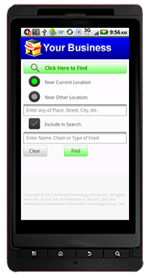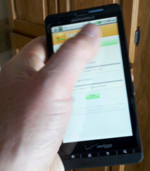A New Android Market App
Google is rolling out a new Market app that will allow them to compete more effectively with stores such as those provided by Amazon and Apple.
 Android,
Android,  Apple,
Apple,  Apps,
Apps,  Devices,
Devices,  E Commerce,
E Commerce,  Marketing,
Marketing,  Smartphones
Smartphones tel. 970 708 0899
fax. 970 497 4377
contact@marketimpacts.com
Click below to download free QuickClick apps for your Android smartphone...





Get a custom QuickClick app for your business. Use the format you see here or let us create a custom format tailored to your needs.

Google is rolling out a new Market app that will allow them to compete more effectively with stores such as those provided by Amazon and Apple.
There is speculation that an upcoming version of the Google Android platform (possibly 3.2) may have better options for displaying apps on tablets that are sized for smartphones.
Apps would have both stretch and zoom options. Zoom would be a new mode that would simulate a smartphone display and then fill the tablet screen with it.
The purpose is to give Android tablet users greater access to Android Market apps, the majority of which are designed for smartphone screens. Since smartphones greatly outnumber tablets, this seems to us to be a great idea. Some smartphone apps incorporate a mixture of screen size optimizations. For example, our QuickClick Locales series of apps use a smartphone sized screen for user query input and mapping function that is optimized for both smartphones and tablets.

 Android,
Android,  Apps,
Apps,  Design,
Design,  Devices,
Devices,  E Commerce,
E Commerce,  Marketing,
Marketing,  Smartphones,
Smartphones,  Tablets
Tablets 

Naming and creating symbols for your app, tabs, sections is important as an aid in remembering where users have been and where they want to go.

Apple and Google are changing the way they rank apps in their markets. Although the exact formulas are kept secret, there is talk and news that they are moving away from basing rankings on downloads and now using a formula based on the "sticky-ness" of apps.
The sticky formula is based on the ratio daily active users to monthly active users. So just getting users to download an app no longer gets a high rating. Users need to actually use an app to move it up in the ratings. Seems to make sense. After all, they are called "users" not "downloaders."

That's the name of their upcoming Android release due out in the fourth quarter of 2011. A major component of the release will be a "run anywhere" set of features that will allow Android apps to run on all Android devices regardless of the exact phone configuration. Looks tasty.

The news is full of stories about interest in and growth of cloud computing ... relying on services hosted on servers owned, operated and maintained by others. Some get nervous about having their information located in places they don't control. The growth of smartphones should, however, accelerate the move to cloud computing and gradually ameliorate those fears.
Relying on cloud computing with a smartphone, or tablet, isn't an option. It's all controlled "in the clouds." Faster and more reliable networks will also help. Over time, whether computing is done on your device or in the cloud should become a somewhat meaningless distinction.

A new study has shown that nearly 20 percent of smartphone users in the U.S. use check-in services. The study was conducted by researchers from ComScore. Check-in lets visitors take advantage of special offers and discounts and, if they choose, let friends know where they are.

Google has just announced a group of hardware and software platforms for using Android tablets and other devices to control real world objects. Developers are being invited to create applications for these platforms that could control anything from lighting to heavy duty equipment. Android@Home is part of the initiative and will let Android software apps discover, connect and communicate with devices in the home. Below is a photo of the hardware controller used to interface Android with objects.
